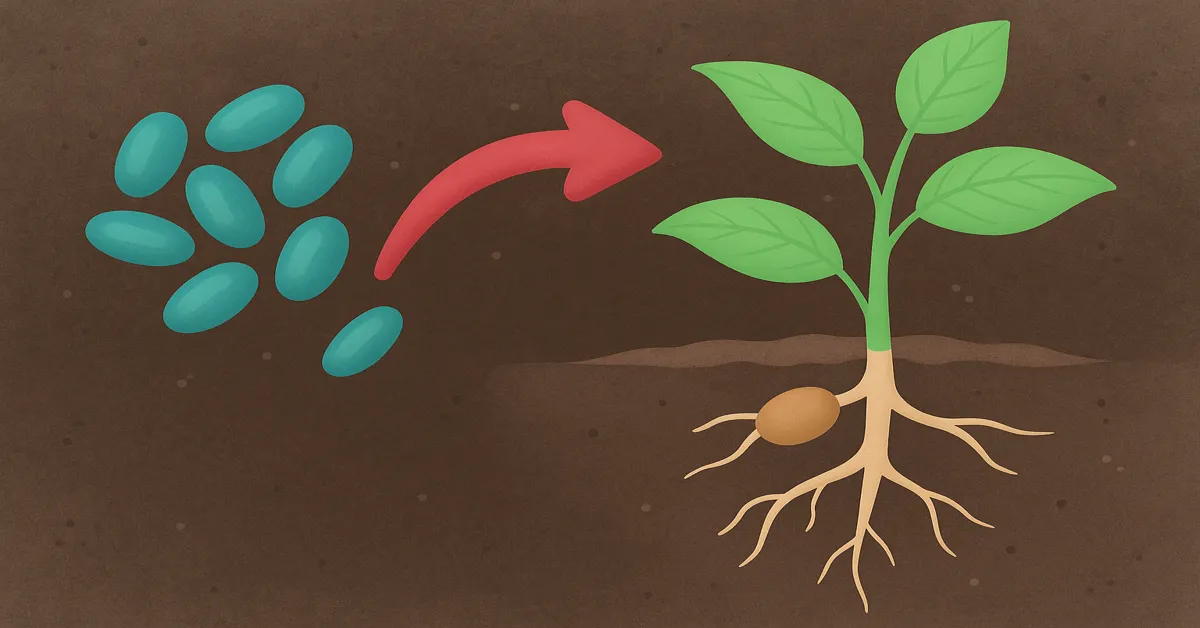In the diverse microbial world beneath the soil, where microscopic organisms compete for space and sustenance, survival often depends not just on movement—but on precision. For Bradyrhizobium japonicum, the bacterium responsible for fixing nitrogen in soybean roots, that precision takes shape at a single pole of its otherwise symmetrical cell. Here, a tiny but powerful carbohydrate-binding protein called BJ38 orchestrates the dance of recognition, attachment, and biological cooperation.
Scientists have long understood that bacteria and legumes co-evolved with remarkable specificity. But the discovery of BJ38’s unipolar localization adds a new layer to the story: one of molecular directionality, cell surface choreography, and the mechanics of communication between microbe and plant.
This is the story of how a 38-kilodalton lectin can shape the start of a life-sustaining alliance.
The Microbial Diplomat: BJ38 in Context
BJ38 is a lectin—a protein that binds specific carbohydrates with high affinity. In B. japonicum, it is particularly attuned to galactose and lactose residues, suggesting a refined ability to detect and anchor to molecules commonly found on plant cell walls. But BJ38 is more than a molecular Velcro strip. It is strategically positioned—not randomly scattered across the bacterium’s surface but deliberately located at one end of the cell.
This unipolar localization is not an accident of evolution. It is a design.
Under electron microscopes, BJ38 appears as a tuft-like structure on one pole of the bacterium, sitting just beyond the outer membrane. This focused placement allows the bacterium to present its binding domain like a handshake offered from a single, extended hand. And in the competitive soil environment, that handshake has to be fast, sticky, and unmistakable.
Adhesion Is a One-Way Street—And That’s the Point
BJ38’s unique positioning provides two key advantages. First, it facilitates selective binding to host plant cells, particularly the root hairs of soybeans. Second, it supports aggregation with other bacteria, allowing B. japonicum to form protective clusters and biofilms that can stabilize early root colonization.
These behaviors were demonstrated through a variety of assays:
- In homotypic aggregation assays, B. japonicum cells formed star-shaped clusters, an effect completely inhibited by the presence of lactose or galactose. This confirmed that carbohydrate binding was central to the process.
- In plant adhesion studies, the bacterium demonstrated strong binding to soybean root tissue, again with inhibition observed when specific sugars were introduced to compete with lectin binding.
- In surface bead assays, BJ38 showed specific affinity for lactose-Sepharose columns—further validating its sugar-binding profile.
Across all models, one detail was consistent: binding occurred only at the pole where BJ38 was located.
The Asymmetry of Symbiosis
Interestingly, soybean cells themselves express lectins—proteins that also bind sugars—and these lectins bind to the opposite pole of the B. japonicum cell from where BJ38 is found. This suggests a remarkably coordinated dual-recognition system: the bacterium presents its lectin at one end, while the plant binds at the other. This structural choreography ensures precise alignment during symbiotic initiation.
Why would bacteria and plants evolve to recognize each other at opposing poles? The likely answer lies in directional signaling and avoidance of redundancy. By organizing binding sites asymmetrically, the interaction becomes targeted, regulated, and non-random—an essential feature in the highly competitive rhizosphere.
A Closer Look: What Makes BJ38 Unique?
| Feature | Description |
|---|---|
| Protein type | Lectin (carbohydrate-binding protein) |
| Molecular weight | 38 kilodaltons |
| Localization | Unipolar, outer membrane projection |
| Sugar specificity | Strong affinity for galactose and lactose |
| Functional roles | Bacterial aggregation, plant cell adhesion |
| Inhibition profile | Disrupted by galactose/lactose only |
These details make BJ38 more than just a binding protein; they make it a navigation tool that guides the bacterium through its first contact with a plant partner.
The Bigger Picture: Why Polar Localization Matters
Bacteria are often depicted as simple, symmetrical rods, but recent science tells us they are spatially complex organisms. Like neurons or epithelial cells, they can polarize—that is, they can differentiate their ends to specialize in different functions.
BJ38 is part of this cellular polarity. By localizing exclusively to one pole, it serves as a site of action, focusing binding where it’s needed most. Other examples of bacterial polarity include:
- Chemoreceptors that localize to flagellar ends to guide movement
- Secretion systems that form only at certain poles
- Division proteins that accumulate to initiate fission
BJ38 adds a new function to this growing list: plant recognition and adhesion.
Rooted in Sugar: Why Carbohydrates Matter
Plants express a range of complex carbohydrates on their cell surfaces, particularly in the root hairs and outer membranes. These sugars serve as signposts—indicating species, stress state, developmental stage, and more.
BJ38’s specificity to galactose and lactose likely evolved in response to these plant signals. Its high affinity ensures that B. japonicum doesn’t waste energy binding to non-host plants or environmental debris. It’s a classic case of lock-and-key molecular evolution: the key (BJ38) evolved to fit only one kind of lock (soybean sugars).
From Protein to Process: Building the Symbiosis
The full cycle of B. japonicum-soybean interaction unfolds in steps:
- Recognition: BJ38 binds to galactose-bearing structures on soybean roots.
- Aggregation: Other bacteria bind via their own BJ38 tufts, forming colonies.
- Invasion: The bacterium enters root hair cells through infection threads.
- Nodulation: The plant forms nodules, housing the bacteria in exchange for fixed nitrogen.
BJ38’s role is confined to the earliest stage—the initiation point. Without successful binding, none of the downstream processes can occur.
Scientific and Agricultural Implications
Understanding BJ38 has broad significance:
- Agricultural efficiency: Enhancing BJ38 expression or targeting could improve nodulation success in soybean crops, especially in nutrient-poor soils.
- Bioengineering potential: Transferring BJ38-like genes to other beneficial microbes could support engineered symbioses in non-legume plants.
- Soil microbiome control: Knowing how BJ38 interacts with root exudates could allow farmers to tweak soil environments to favor beneficial colonization.
In a world where sustainable agriculture is vital, such molecular tools offer new hope.
Challenges and Unknowns
Despite its promise, several questions about BJ38 remain:
- How is the lectin trafficked to one pole?
The mechanism of asymmetric localization is unclear. Does it rely on cytoskeletal scaffolding or membrane transport proteins? - Does its expression vary with environmental cues?
Is BJ38 always present, or is it upregulated in the presence of plant signals? - Are there analogs in other rhizobia?
Could this strategy of polar lectin deployment be a common theme across other symbiotic bacteria?
These open questions form the roadmap for future microbiological research.
BJ38 as a Case Study in Cell Surface Engineering
In many ways, BJ38 represents a microcosm of how bacteria engineer their surfaces. Instead of broadcasting all capabilities equally, they localize function to one area, increasing efficiency and precision. It’s a strategy echoed in:
- Host-pathogen interactions
- Biofilm formation
- Quorum sensing and signaling platforms
BJ38’s design isn’t just beautiful biology—it’s optimized engineering, shaped by billions of years of evolution.
Final Thoughts: More Than a Binding Protein
BJ38 teaches us that sometimes the most important interactions begin at the edge—at one pole, with one sugar, on one surface. Its unipolar localization reveals a deep evolutionary truth: in nature, direction matters. Where something happens can be as important as how or why.
For Bradyrhizobium japonicum, BJ38 offers a directional identity—a molecular handshake that ensures it finds, binds, and builds with the right partner. And in doing so, it reminds us that in the quiet soil beneath our feet, incredible intelligence is at work—one pole at a time.
FAQs
1. What is BJ38 in Bradyrhizobium japonicum?
BJ38 is a 38-kilodalton lectin (carbohydrate-binding protein) found on the surface of Bradyrhizobium japonicum. It specifically binds galactose and lactose sugars and is involved in bacterial self-aggregation and adhesion to soybean root cells, playing a key role in initiating nitrogen-fixing symbiosis.
2. Why is BJ38 located at only one pole of the bacterial cell?
BJ38 exhibits unipolar localization, meaning it’s found at just one end of the bacterium. This strategic positioning enhances targeted adhesion to plant root cells and enables efficient recognition of host surfaces during the early stages of symbiosis. It reflects a specialized form of bacterial polarity.
3. How does BJ38 influence symbiotic relationships with soybeans?
BJ38 mediates initial attachment to soybean root hairs by binding specific sugar residues on plant cells. This contact is critical for the development of infection threads, which allow the bacteria to enter the plant and establish nitrogen-fixing nodules, benefiting crop growth.
4. Can BJ38’s function be disrupted?
Yes. Experiments show that BJ38’s binding activity can be inhibited by the presence of free galactose or lactose in the environment. These sugars outcompete plant-bound sugars, preventing BJ38 from attaching and blocking aggregation or root binding.
5. What potential applications does BJ38 have in agriculture?
Understanding BJ38’s role could lead to improved biofertilizer design, enhance nodulation efficiency in soybeans, or be applied in synthetic biology to engineer other microbes for beneficial plant interactions. It represents a model for studying targeted bacterial-plant communication.











